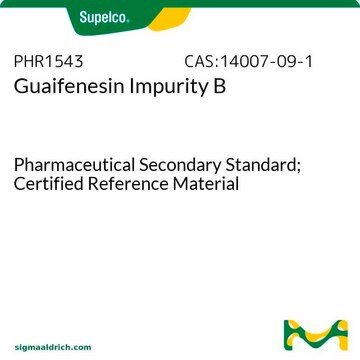Y0000619
Guaiacol
European Pharmacopoeia (EP) Reference Standard
Sinónimos:
2-Methoxyphenol, Catechol monomethyl ether, Pyrocatechol monomethyl ether
About This Item
Productos recomendados
grado
pharmaceutical primary standard
Agency
EP Reference Standard
densidad de vapor
4.27 (vs air)
presión de vapor
0.11 mmHg ( 25 °C)
familia API
guaiacol
fabricante / nombre comercial
EDQM
índice de refracción
n20/D 1.543 (lit.)
bp
205 °C (lit.)
mp
26-29 °C (lit.)
densidad
1.129 g/mL at 25 °C (lit.)
aplicaciones
pharmaceutical (small molecule)
formato
neat
temp. de almacenamiento
2-8°C
cadena SMILES
COc1ccccc1O
InChI
1S/C7H8O2/c1-9-7-5-3-2-4-6(7)8/h2-5,8H,1H3
Clave InChI
LHGVFZTZFXWLCP-UHFFFAOYSA-N
¿Está buscando productos similares? Visita Guía de comparación de productos
Descripción general
Aplicación
Acciones bioquímicas o fisiológicas
Envase
Otras notas
Producto relacionado
Palabra de señalización
Warning
Frases de peligro
Consejos de prudencia
Clasificaciones de peligro
Acute Tox. 4 Oral - Eye Irrit. 2 - Skin Irrit. 2
Código de clase de almacenamiento
11 - Combustible Solids
Clase de riesgo para el agua (WGK)
WGK 1
Punto de inflamabilidad (°F)
179.6 °F - closed cup
Punto de inflamabilidad (°C)
82 °C - closed cup
Choose from one of the most recent versions:
Certificados de análisis (COA)
Sorry, we don't have COAs for this product available online at this time.
If you need assistance, please contact Atención al cliente
¿Ya tiene este producto?
Encuentre la documentación para los productos que ha comprado recientemente en la Biblioteca de documentos.
Nuestro equipo de científicos tiene experiencia en todas las áreas de investigación: Ciencias de la vida, Ciencia de los materiales, Síntesis química, Cromatografía, Analítica y muchas otras.
Póngase en contacto con el Servicio técnico





